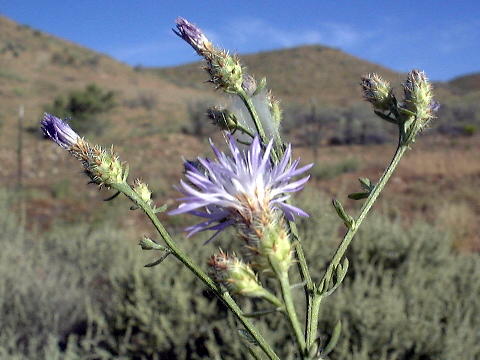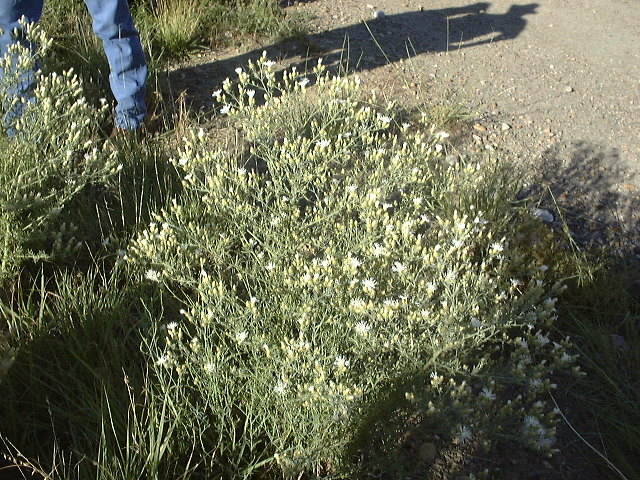 Diffuse Knapweed: A Bad Actor - December 21, 2011 Jeff Schalau, Agent, Agriculture & Natural Resources University of Arizona Cooperative Extension, Yavapai County The winter precipitation we have received so far this year has already gotten many cool season weeds growing - including invasive and/or noxious weed species. Invasive weeds have the ability to invade undisturbed ecosystems and displace native plant species. By definition, noxious weeds are plants specified by law or regulation to be particularly undesirable, destructive and difficult to control. In the Verde Valley area, some of these are diffuse knapweed, Russian knapweed, Dalmatian toadflax, Scotch thistle, sweet resinbush, yellow starthistle, and Malta starthistle. Diffuse knapweed (Centaurea diffusa) is native to disturbed areas and seashores from southern Europe to north-central Ukraine. In Europe, it is generally is found on dry, light, porous soils. Diffuse knapweed will not tolerate flooding or shade and thrives in the semiarid west (generally in 9- to 16-inch precipitation zones). Environmental disturbance (e.g., overgrazed rangeland, roadsides, rights-of-way, gravel piles, etc.) promotes its invasion. In northern Arizona, diffuse knapweed has taken hold in the in Flagstaff and Sedona areas. In Flagstaff, it is all over the east side of town. In Sedona, you may see diffuse knapweed along Highway 179 between the Village and the “Y”, in the Seven Canyons/Upper Dry Creek area, the Palatakai Ruin site, or in other areas where it has spread. Diffuse knapweed can be a short-lived perennial, a biennial, or occasionally an annual and reproduces and spreads from seed. Young plants start out as a rosette with finely divided leaves (somewhat like a dandelion). Later in the growing season, it develops a single shoot (stem), 1 to 2 feet tall, that branches toward the top. Grazed plants may produce multiple stems. Leaves become smaller toward the top of the shoot and have smooth margins. Diffuse knapweed produces flowers in early- to mid-summer with many solitary flowering heads occur on shoot tips. Flowers are about 1/8 inch in diameter and 1/2 to 2/3 inch long. They resemble small thistle flowers that are white but may be purplish. The have pointy bracts on the green portion at the base of the flower. These bracts (called the involucre) are divided like teeth on a comb and tipped with a slender spine that makes them prickly to the touch. Sometimes the bracts are dark-tipped or spotted like spotted knapweed. Diffuse knapweed can be controlled in small areas by hand grubbing. You should always wear heavy gloves because it can cause severe skin irritation. It is best to get the rosettes before they flower. However, you can successfully hand grub more mature plants. Just be sure to get as much of the taproot as possible as it has adventitious buds that will resprout. If flowers have matured and seed is present, then all plants should be double bagged in heavy duty plastic bags. Herbicides are available that will control broadleaf plants (including diffuse knapweed) without harming desirable grasses. The most effective herbicides are restricted use (only available to certified applicators) and should only be used on large areas. Repeated treatments are usually necessary. Any control method should be accompanied by cultural practices such as planting desirable perennial grasses to occupy the space and decrease the probability of reinvasion. Insects have been collected from diffuse knapweed’s native range and evaluated under controlled conditions to ensure they will not harm desirable plant species. These particular flies, moths, and beetles are also being used to manage diffuse knapweed. It is best to integrate all the available management tools when managing invasive plants. Diffuse knapweed is also known as tumble knapweed because it will often snap off at ground level after it dries out. After this, it can be blown by wind and seed is then dispersed across the landscape. Human activity, including vehicle traffic, hikers, horseback riders, mountain bikers, etc. can also unknowingly disseminate seeds. More information and photos of diffuse knapweed are included below. Follow the Backyard Gardener on Twitter – use the link on the BYG website. If you have other gardening questions, call the Master Gardener line in the Camp Verde office at 928-554-8999 Ext. 3 or e-mail us at cottonwoodmg@yahoo.com and be sure to include your name, address and phone number. Find past Backyard Gardener columns or provide feedback at the Backyard Gardener web site: http://cals.arizona.edu/yavapai/anr/hort/byg/.  Photo of diffuse knapweed flower.  Photo of diffuse knapweed plant. Additional Resources Link to Colorado State University publication Diffuse and Spotted Knapweed (www.ext.colostate.edu/pubs/natres/03110.html) Link to University of Nevada publication Managing Diffuse Knapweed (www.unce.unr.edu/publications/files/nr/2004/FS0429.pdf) |